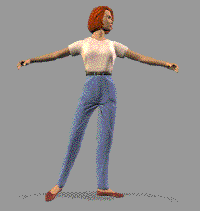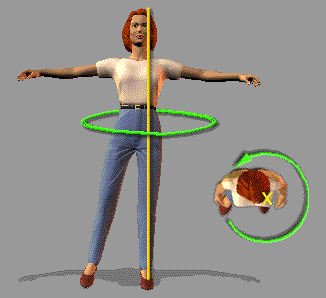Spins and Turns
Exercise 1: Turns on One Foot
Turning with the weight held over one foot requires that you have a solid
understanding and awareness of your left- and right-side axes. The following exercise
teaches your body, very slowly over time, how to find and maintain your balance on one
foot as you turn around these axes.
 Example 1
Example 1
Following the description in Lesson 4, Part 2: Turns
With The Left and Right Side Leading, step sideways with your foot and leg turned
toward the direction of your step. Leave the free foot pointing to the side for the
duration of the exercise. Note: Your body will feel this as a side step, but your foot and
leg will feel it as a forward step. (See Example 6.1, above).
Make sure that your weight is properly positioned over the standing foot,
so that you retain absolutely no weight on your free (pointing) foot. If you feel any
pressure on your free foot, it means that you still have some weight on it, so you must
move the body more completely over the standing foot. You can spot-check yourself by
trying to lift the free foot an inch off of the floor for a few seconds. Your body will
automatically shift to the correct position to do this, or else you won't be able to keep
the free foot off of the floor for longer than a second or so.
 Example 2
Example 2
You have now established an axis through the shoulder, hip and foot. When
you turn, the side of the body of the free foot will rotate forward or backward around the
side of the body of the standing foot.
Using the muscles in your standing leg and foot, turn your body with just
a small fraction of a turn. (1/16 of a turn or less). The direction of rotation is
arbitrary. Although the leg and foot are the motivating force, the entire body should turn
as a unit. The body position itself should actually remain unaffected... try to avoid any
wiggling or bobbling. Make sure that the body weight remains exactly over the standing
foot.
Continually repeat the above process, turning in the same direction, with
the same small increments of turn. With each increment, you should feel that your weight
remains over the standing foot, with the free foot pointing to the side. Your body should
not wiggle or bobble; It should turn altogether as a whole unit. You can use the free foot
to lightly paddle, but you should not feel any pressure whatsoever into the foot.
This exercise should be practiced 4 ways:
- Weight on LF, body turning to left.
- Weight on LF, body turning to right.
- Weight on RF, body turning to right.
- Weight on RF, body turning to left.
The goal of this exercise is to
teach yourself how to remain on your standing foot and axis as you turn. Therefore, you
should always turn in small enough increments to maintain this balance. If you find
yourself putting pressure into the pointing foot or worse, shifting weight between the
feet as you turn, it means that your increments are too large, and you must slow down.
Over time, you will gradually increase the increments to the point where
you can take an entire turn at once. It is not necessary to try to increase the
amount of rotation; It will just happen. The most important thing to remember is that at
any and every point in your learning process, your increments must be small enough
that you can consistently maintain balance over your standing foot. If you focus
your efforts on maintaining your balance rather than testing to see how far you can turn
in one step, you are teaching yourself how to find the axis, and you will naturally
improve over time. If you give in to your own impatience, you will rob yourself of this
opportunity.

 Example 1
Example 1